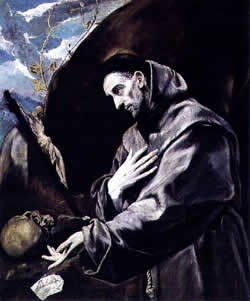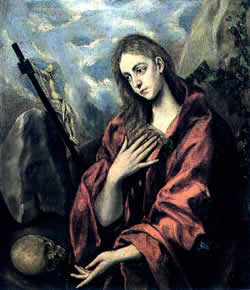
El Greco, St Mary Magdalene in Penitence with the Crucifix (ca. 1587-97, oil on canvas, 109 x 96 cm, Sitges, Musée del Cau Ferrat)
This painting expresses a stronger affinity to the tradition of penitence. The hair is reduced; the breasts are wrapped in a garment, which she clasps with her left hand in order to hide her beauty. The purple colour of her cloak associates her with the Great Babylon, the mother of all harlots (Revelation 17: 5). The rock, symbol of solidity and duration, has been marginalised. There is no nimbus whatsoever. In order to appreciate the contrast, it might be worthwhile having a look at El Greco's Saint Francis in Prayer.
El Greco, The Penitent Magdalene (ca. 1603-07, oil on canvas, 118 x 105 cm, Bilbao, Felix Valdés Izaguirre Collection)
In this painting, the skull is hidden behind the book. St Mary Magdalene is reading, thus casting a doubt on the seriousness of her endeavours to reform her attitude of mind. One hand is pointing towards heaven while the other one is pointing down - indicating an undecided state of mind. Similarly, her hair is still wild and resembles the vines growing to her right, which shows that she is still strongly bound to her earthly desires. The folds of her garments resemble the rifts between the clouds so that her inner struggle is taken up on a cosmic level. One of her breasts is bare again - hardly concealed by her hair and her hand.
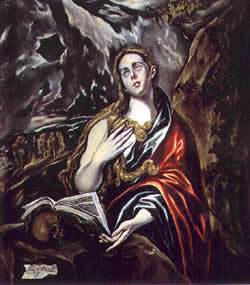
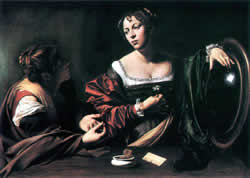
El Greco has painted several St Mary Magdalene in Penitence paintings - and they differ considerably. The earlier painting shows her in a persistent attitude of pride and conceit; her clothes are still meant to highlight her erotic attractions rather than concealing them. Her face is turned away from the skull, which is hidden behind the flask of ointment. Her posture is somewhat twisted serpentine; her hair is still wild and uncontrolled. The flask which is meant to hold the precious ointment has been marginalised and looks like a rather secular bottle.
This painting, which had been commissioned for a convent and was not exposed to male viewers, shows the penitent Magdalene like a pagan mermaid with a strong association of a naiad-like nature. Her posture is twisted and lascivious. She uses the crucifix to prop up the book; her nakedness is hardly concealed by her hair. Her blue garments continue the colours of the wild sea. Rays of heavenly light break through the clouds - but they don't reach the penitent Magdalene - except her breasts, which are certainly the dominant focal element of the painting. Her face suggests that she is still longing for earthly pleasures rather than spiritual elevation.
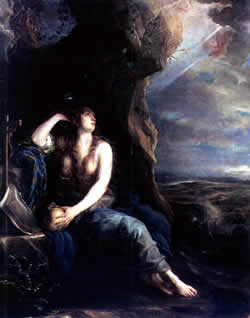
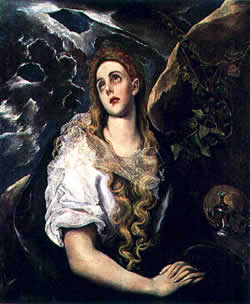
El Greco, St. Mary Magdalene in Penitence (ca. 1607), Arango Collection (118 x 105 cm)
Compared with previous representations of Mary Magdalene as a penitent sinner, El Greco's 1607 version is the most dramatic and ambiguous: in front of a threateningly dark sky rent into fragments by looming sombre clouds a weeping Mary distractedly gazes into the beyond. Her upward gaze is, however, modified by one of her hands pointing downwards; and the part of her body covered by the blue and red garment traditionally associated with the Virgin Mary is juxtaposed with her naked right breast which she enticingly covers with her curly blond hair.
El Greco's painting epitomises the dramatic paradox of the Baroque iconography of Mary Magdalene: while one half of her personality is identified with the chaste mater dolorosa, the other half strongly reminds the spectator of a sexually attractive Venus physically enamoured of an erotically appealing Christ.
